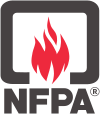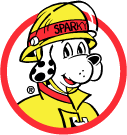National Fire Protection Association
 | |
| Abbreviation | NFPA |
|---|---|
| Formation | 1896 |
| Headquarters | Quincy, Massachusetts |
| Coordinates | 42°13′49″N 71°01′33″W / 42.230178°N 71.025925°W |
Volunteers | 6000+ |
| Website |
www |
The National Fire Protection Association (NFPA) is a United States trade association, albeit with some international members, that creates and maintains private, copyrighted standards and codes for usage and adoption by local governments. This includes publications from model building codes to the many on equipment utilized by firefighters while engaging in hazardous material (hazmat) response, rescue response, and some firefighting.
History
The NFPA was formed in 1896[1] by a group of insurance firms with the stated purpose of standardizing the new and burgeoning market of fire sprinkler systems. The scope of the NFPA's influence grew from sprinklers and fire extinguishers to include building electrical systems (another new technology), and then into almost all aspects of building design and construction.
Its original membership was limited to insurance underwriting firms and there was no representation from the industries the NFPA sought to control. This changed in 1904 to allow other industries and individuals to participate in the development of the standards to be promulgated by the NFPA. The first fire department to be represented in the NFPA was the New York City Fire Department in 1905, though their participation has declined steadily since then. Today, the NFPA includes representatives from some fire departments, many fire insurance companies, many manufacturing associations, some trade unions, many trade associations, and engineering associations.
NFPA today
NFPA defines its mission as follows: "We help save lives and reduce loss with information, knowledge and passion."[2]
NFPA membership totals more than 65,000 individuals around the world.[3]
Codes and standards
NFPA is responsible for 380 codes and standards[4] that are designed to minimize the risk and effects of fire by establishing criteria for building, processing, design, service, and installation in the United States, as well as many other countries. Its more than 200 technical code- and standard- development committees have over 6,000 volunteer seats. Volunteers vote on proposals and revisions in a process that is accredited by the American National Standards Institute (ANSI).
Some of the most widely used codes are:
- NFPA 1, Fire Code:[5] Provides requirements to establish a reasonable level of fire safety and property protection in new and existing buildings.
- NFPA 54, National Fuel Gas Code:[6] The safety benchmark for fuel gas installations.
- NFPA 70, National Electric Code:[7] The world's most widely used and accepted code for electrical installations.
- NFPA 85: Boiler and Combustion Systems Hazards Code:[8]
- NFPA 101, Life Safety Code:[9] Establishes minimum requirements for new and existing buildings to protect building occupants from fire, smoke, and toxic fumes.
- NFPA 704, Standard System for the Identification of the Hazards of Materials for Emergency Response:[10] Defines the "fire diamond" used by emergency personnel to quickly and easily identify the risks posed by hazardous materials.
Public safety education
Sponsoring a variety of life-saving campaigns and training programs, the NFPA devotes much of its efforts to protecting lives and property through education. The organization provides many resources for fire, electrical, and life-safety instructions.

The outreach programs of NFPA include:
- The annual Fire Prevention Week in October, a national campaign for which NFPA has been the official sponsor since 1922;[11]
- Remembering When, a program developed to address the leading causes of injuries and death among older adults;[12]
- Risk Watch[13] and Learn Not to Burn,[14] programs developed to address the leading causes of injuries and death among children;
- A variety of programs that focus on high-risk outreach;
- and the resources and activities associated with Sparky the Fire Dog, the official mascot of NFPA.
Advocacy
NFPA oversees the operations of several advocacy campaigns dedicated to increasing fire safety and awareness, including the Fire Sprinkler Initiative, Bringing Safety Home; Electric Vehicle Safety Training Program; the Coalition for Fire-Safe Cigarettes; Firewise Communities/USA; and the Alliance to Stop Consumer Fireworks.
Sparky the Fire Dog
NFPA's official mascot since 1951, Sparky hosts his own Web site[15] to provide materials for others (mostly the fire service) to teach children about fire safety. Sparky has been featured in his own series of television public service announcements.
Access to NFPA codes and standards
As part of its commitment to enhancing public safety through the adoption and enforcement of key ANSI codes and standards, NFPA makes all of its codes and standards available for review online by the public. The complete texts of standards documents are available on the NFPA Web site for viewing, but not printing.[16] NFPA codes and standards are widely adopted, because they are developed using an open, consensus-based process. All NFPA codes and standards are developed and periodically reviewed by approximately 7,000 volunteer committee members with a wide range of professional expertise.[17]
In 2013, NFPA with others filed suit against Public.Resource.Org for publishing the full texts of various codes.[18] PRO claims that since these codes form part of US or state law they are not eligible for copyright.
See also
- NFPA Standards:
- NFPA 70 — National Electrical Code
- NFPA 70B — Recommended Practice for Electrical Equipment Maintenance
- NFPA 70E — Standard for Electrical Safety in the Workplace
- NFPA 72 — National Fire Alarm and Signaling Code
- NFPA 101 — Life Safety Code
- NFPA 704 — Standard System for the Identification of the Hazards of Materials for Emergency Response (four-color hazard diamond)
- NFPA 921 — Guide for Fire and Explosion Investigations
- NFPA 1001 — Standard for Fire Fighter Professional Qualifications
- NFPA 1123 — Code for Fireworks Display
- NFPA 1670 — Standard on Operations and Training for Technical Search and Rescue Incidents
- NFPA 1901 — Standard for Automotive Fire Apparatus
References
- ↑ "About NFPA". National Fire Protection Association. Retrieved 2014-11-11.
- ↑ "NFPA Overview". NFPA. NFPA. Retrieved 8 July 2015.
- ↑ "About NFPA". NFPA. NFPA. Retrieved 8 July 2015.
- ↑ "Codes & Standards". National Fire Protection Association.
- ↑ "NFPA 1, Fire Code". National Fire Protection Association.
- ↑ "NFPA 54, National Fuel Gas Code". National Fire Protection Association.
- ↑ "NFPA 70, National Electric Code". National Fire Protection Association.
- ↑ "NFPA 85, Boiler and Combustion Systems Hazards Code". National Fire Protection Association. Retrieved 1 March 2014.
- ↑ "NFPA 101, Life Safety Code". National Fire Protection Association.
- ↑ "NFPA 101, Standard System for the Identification of the Hazards of Materials for Emergency Response". National Fire Protection Association.
- ↑ "About Fire Prevention Week". National Fire Protection Association.
- ↑ "Remembering When". National Fire Protection Association.
- ↑ "Risk Watch". National Fire Protecion Association.
- ↑ "Learn Not To Burn Preschool Program". National Fire Protection Association.
- ↑ Sparky the Fire Dog official website
- ↑ "List of NFPA codes and standards". National Fire Protection Association.
- ↑ "Standards development process". National Fire Protection Association.
- ↑ First Word
- "How Codes and Standards are Developed". National Fire Protection Association.
- "Overview of NFPA". National Fire Protection Association.